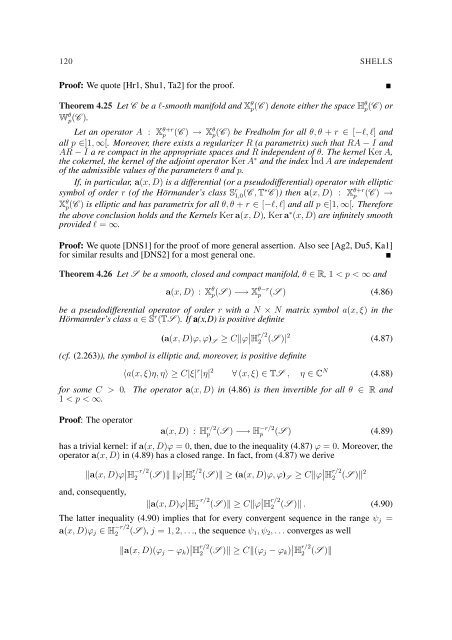EQUATIONS OF ELASTIC HYPERSURFACES
EQUATIONS OF ELASTIC HYPERSURFACES
EQUATIONS OF ELASTIC HYPERSURFACES
You also want an ePaper? Increase the reach of your titles
YUMPU automatically turns print PDFs into web optimized ePapers that Google loves.
120 SHELLS<br />
Proof: We quote [Hr1, Shu1, Ta2] for the proof.<br />
Theorem 4.25 Let C be a l-smooth manifold and X θ p(C ) denote either the space H θ p(C ) or<br />
W θ p(C ).<br />
Let an operator A : X θ+r<br />
p (C ) → X θ p(C ) be Fredholm for all θ, θ + r ∈ [−l, l] and<br />
all p ∈]1, ∞[. Moreover, there exists a regularizer R (a parametrix) such that RA − I and<br />
AR − I a re compact in the appropriate spaces and R independent of θ. The kernel Ker A,<br />
the cokernel, the kernel of the adjoint operator Ker A ∗ and the index Ind A are independent<br />
of the admissible values of the parameters θ and p.<br />
If, in particular, a(x, D) is a differential (or a pseudodifferential) operator with elliptic<br />
symbol of order r (of the Hörmander’s class S r 1,0(C , T ∗ C )) then a(x, D) : X θ+r<br />
p (C ) →<br />
X θ p(C ) is elliptic and has parametrix for all θ, θ + r ∈ [−l, l] and all p ∈]1, ∞[. Therefore<br />
the above conclusion holds and the Kernels Ker a(x, D), Ker a ∗ (x, D) are infinitely smooth<br />
provided l = ∞.<br />
Proof: We quote [DNS1] for the proof of more general assertion. Also see [Ag2, Du5, Ka1]<br />
for similar results and [DNS2] for a most general one.<br />
Theorem 4.26 Let S be a smooth, closed and compact manifold, θ ∈ R, 1 < p < ∞ and<br />
a(x, D) : X θ p(S ) −→ X θ−r<br />
p (S ) (4.86)<br />
be a pseudodifferential operator of order r with a N × N matrix symbol a(x, ξ) in the<br />
Hörmanrder’s class a ∈ S r (TS ). If a(x,D) is positive definite<br />
(a(x, D)ϕ, ϕ) S ≥ C‖ϕ ∣ ∣ H<br />
r/2<br />
2 (S )| 2 (4.87)<br />
(cf. (2.263)), the symbol is elliptic and, moreover, is positive definite<br />
for some C > 0.<br />
1 < p < ∞.<br />
Proof: The operator<br />
〈a(x, ξ)η, η〉 ≥ C|ξ| r |η| 2 ∀ (x, ξ) ∈ TS , η ∈ C N (4.88)<br />
The operator a(x, D) in (4.86) is then invertible for all θ ∈ R and<br />
a(x, D) : H r/2<br />
p (S ) −→ H −r/2<br />
p (S ) (4.89)<br />
has a trivial kernel: if a(x, D)ϕ = 0, then, due to the inequality (4.87) ϕ = 0. Moreover, the<br />
operator a(x, D) in (4.89) has a closed range. In fact, from (4.87) we derive<br />
‖a(x, D)ϕ ∣ ∣ H<br />
−r/2<br />
2 (S )‖ ‖ϕ ∣ ∣ H<br />
r/2<br />
2 (S )‖ ≥ (a(x, D)ϕ, ϕ) S ≥ C‖ϕ ∣ ∣ H<br />
r/2<br />
2 (S )‖ 2<br />
and, consequently,<br />
‖a(x, D)ϕ ∣ −r/2 H 2 (S )‖ ≥ C‖ϕ ∣ r/2 H 2 (S )‖ . (4.90)<br />
The latter inequality (4.90) implies that for every convergent sequence in the range ψ j =<br />
a(x, D)ϕ j ∈ H −r/2<br />
2 (S ), j = 1, 2, . . ., the sequence ψ 1 , ψ 2 , . . . converges as well<br />
‖a(x, D)(ϕ j − ϕ k ) ∣ ∣ H<br />
r/2<br />
2 (S )‖ ≥ C‖(ϕ j − ϕ k ) ∣ ∣ H<br />
r/2<br />
2 (S )‖

















